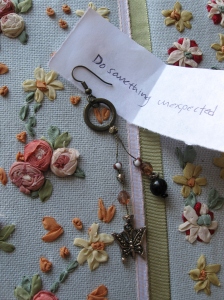There are many ways to keep inspiration in our lives. Daily challenges are one way, inspiration boards another. In the spirit on inspiration, here are more ideas to spark your thoughts:
*Inspiration scrapbook or binder. Similar to the board but a permanent landing place that keeps all your ideas in one place. Can be multiple binders, or one with compartments for recipes, weekend activities, home decorating ideas, work projects ideas, favorite sayings, reflective exercises such as “If money were no object …”
*Inspirational quotes, photographs and images. These can be placed anywhere: a photo of your next vacation spot next to the computer monitor at work, a picture of the your dream house tucked into the credit card compartment of your wallet, “if money was no object …” list taped to the mirror.
*Visual reminders of impending deadlines. Some people prefer to track their daily efforts against a larger timeline to keep themselves moving forward. In this case, weekly or monthly goals should be written up in a prominent location. Every week I make a list of topics I want to write about. When I’m fumbling around at 7AM trying to get the words to flow, this list is usually enough to point me in the right direction.
*Visual reminders of progress made. A visual metaphor for progress is a powerful antidote to the voices of self-doubt, laziness, or the mental roadblocks that make it difficult to start your project each day. Pinging is one example. Or place a calendar next to your work spot, and every time you complete your goal – exercise for 20 minutes, write 500 words daily, clean out the attic to make room for your expanding side business – mark that day with a giant X. As the X’s start to accumulate on the calendar, your motivation to keep going comes from two sources: to keep moving towards your goals, but also to keep up that steady stream of X’s. Or say you’re trying to exercise regularly. Put a dollar in a clear glass jar every time you exercise. It’s a nice feeling as the dollars accumulate in the jar, and you can use the jar as fun money to treat yourself to something you wouldn’t otherwise do.
*Images that remind you of your ultimate goal. This keeps the focus towards the ultimate goal and overcomes small temptations along the way that detract from the ultimate goal. A smoker might quit to be around when her grandchildren grow up. One way to encourage her is to put a box of mints or Altoids where she normally keeps her cigarettes, and paste a picture of her grandchildren to the front of the box. If habit kicks in and she automatically reaches for a cigarette she’s immediately reminded of her reasons to quit, instead of growing tempted to have “just one” because the conspicuous absence causes her to fixate on smoking.
Take some time to reflect on what you find most challenging, and where you could use some inspiration. On a day-to-day level, what do you find most difficult? Getting started? Keeping the rhythm? Maybe this means putting the alarm clock across the room and taping an inspirational word or quote to the top of it. Or it could mean setting up a small corner that is solely devoted to your project and making it as warm and inviting as possible.
Or are your efforts uneven from day to day – some days everything comes together, other days progress is slow? What patterns do you notice about both? What rearrangements can you make to increase the number of good days? Maybe you work best by keeping the final product in mind. Or maybe you are most inspired when there’s a tangible short-term product to aim for. For example, if you’re training for a marathon you might find it most motivational to remind yourself “Four months left to train up to 26 miles!” Or you might find it easier to think, “This week I will train up to 12 miles.” Either way, transform these into visual reminders and keep them prominent.
Troubleshoot your problem areas. When do you encounter the most resistance? Be specific. Where are you, what are you thinking, and why are you thinking those thoughts (i.e. what are the underlying emotions that create those thoughts)? Each “W” is an opportunity to change up your routine to overcome resistance to your efforts. For example, you’re trying to eat healthier by eliminating nighttime snacking. What is giving you the most trouble? Perhaps you find yourself constantly going in and out of the kitchen after dinner (where). Is it during commercial breaks (what), because you’re bored (why), because you like to end a meal with something sweet (why)?
Snacking => kitchen => TV => need something mindless to do while watching TV
Each arrow represents a place in the chain to stop the activities that prevent you from reaching your goal. In the link between snacking and the kitchen, you might turn off the lights, close the kitchen door, put signs on the kitchen door, refrigerator, cupboard panels. These signs can be inspirational quotes or reminders of healthy snack alternatives. To address the link between kitchen and TV, keep yourself occupied during commercial breaks. Place a stack of magazines or crossword puzzles next to the couch. To break the link between TV and the need to do something mindless while watching TV, think of various ways to keep your hands occupied. Take up crocheting, work on a jigsaw puzzle, doodle on scratch paper.
Keep inspiration all around you. Keep it physically close to the places you could use extra encouragement. Think about what obstacles you’re facing when you need that extra boost. This offers clues about the best way to use inspiration to keep you moving.




